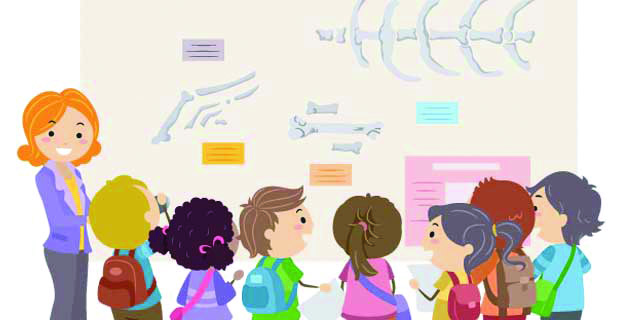
Want to add excitement and adventure to your field trip? Want to make learning new skills and concepts fun while reinforcing classroom topics? Want a trip that is memorable for the kids and for the school? Don’t get trapped in following your predecessors and don’t just “go with the flow.” Be creative and thoughtful, and you’ll stand out amongst your peers. It certainly takes some serious planning and teamwork to create a successful well-focused field trip. Here are five pre-trip steps to help maximize the learning value of any field trip. These apply to planning assemblies as well.
STEP 1: MAKE CONNECTIONS BETWEEN THE TRIP AND THE CURRICULUM
The secret to planning a focused field trip is to make connections between the trip and your curriculum, learning goals and other related projects. Have the curriculum for the term ready, or at least an idea of the major concepts you’ll be working on. Will you be focusing on one main topic or will you be involving multiple concepts - from math, science, language and history to life skills? Trips have to be integrated into the big picture so their lessons aren’t lost. A trip to an amusement park will always be fun, but with planning and preparation, it can also be a vehicle for learning about topics ranging from engineering to why we have to obey rules. What are the goals of the lessons for the term or goals for the grade? What are the difficult concepts? You may even want to build the curriculum around the field trip(s) by listing an overview of all the field trips you might take during the term.
Research and create a list of field trip ideas. Think of places to visit, and then consider each prospective place next to the list of concepts your lessons are focused on. Once you have several ideas for possible field trips, you and your team can begin to narrow down the list. For each idea think about what will be seen there and what there is to do. How does each place correlate with the learning goals for the term, and do they provide opportunities for links between the trips?
STEP 2: WRITE DOWN THE GOALS
Every field trip presents a host of learning opportunities, which is why it’s important to focus on the required goals and list them on paper. Otherwise, you may miss some of the reasons why you are there, and the core concepts may be so diffused that they won’t register with the children. Writing down goals will help ensure that field trips reinforce larger learning objectives, and help you think through projects and activities associated with the field trip.
STEP 3: GATHER THE TROOPS - IT’S A TEAM EFFORT!
You should involve the staff and students in the planning process so that they feel a sense of ownership. Everyone must understand the objectives, goals and their roles. Determine what steps of the trip require teamwork. Engage other teachers and leaders in the planning process, even if it is outside the subject area. A math course can be integrated with a science lesson, history with English, art with architecture or social studies in an effort to meet cross-curriculum requirements. Engage the students and divide them into teams. Involve parents because you may need chaperones, and it will help them feel connected to the learning taking place. Split up roles and responsibilities. Build teams within your classroom or cross-teams between the various groups. Remember that you have separate audiences to engage—the kids, leaders, staff and helpers. For each audience, your planning should cover the three stages of a field trip: pre-trip, the trip itself, and post-tri
STEP 4: VISIT FIRST
Visiting the location in advance of the trip is a smart idea. You will uncover new learning opportunities, staffing needs, and find supporting literature to take back to the class. It will also identify opportunities and challenges before the kids get there, as well as help establish logistics, like the location of bathrooms, dining options, first aid, etc. You may find onsite specialists who you can engage for interviews during the trip. Maybe you’ll determine the destination will not meet the needs of your group and learning objectives.
STEP 5: TRIP PREPARATION WITH KIDS
Work any collected materials into class activities in preparation for the trip. Below are some other ways to get kids prepared and excited in the days before the trip. Give kids input into what they’ll be doing on the trip. Ask them what they would like to see or learn there. Prepare the children by teaching observation skills so that they can get the most out of the experience
For elementary age kids:
STEP 6: THE VISIT ITSELF
During the day of the trip, be prepared with some key activities to enhance the experience while keeping in mind that the trip is supposed to be fun, of course! Make assignments short. Work time into the day for sharing the cameras and taking pictures you can use in specific projects later. Set aside time for recording thoughts in journals. Take a 5-10 minute break to have everyone do an immersion writing activity, or take two minutes after each main exhibit hall for the kids to record all the things they saw. Try to schedule an interviewing project with someone at the site, such as a curator or the person who maintains the roller coaster. On the ride back, have the kids do some writing or drawing activities in their journals, such as recording the five things they liked most and why. Ask the kids to call out all the questions they still have after the trip. Record them as they’re called out—you’ll end up with some great ideas for follow-up research projects on the web or in the library.
POST TRIP - The Planning Doesn’t Stop Here
The sky’s the limit on post trip projects. Classroom discussion and group think work begins. You can build web pages, prepare presentations, write articles for the school newspaper, or create a class bulletin that includes pictures, videos and writing. Be sure not to miss the opportunity to use the trip for mastering skills and tying everything back to the goals of the field trip and key concepts.
